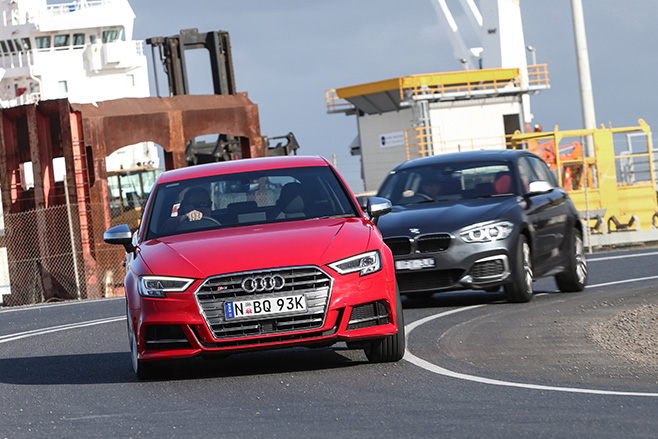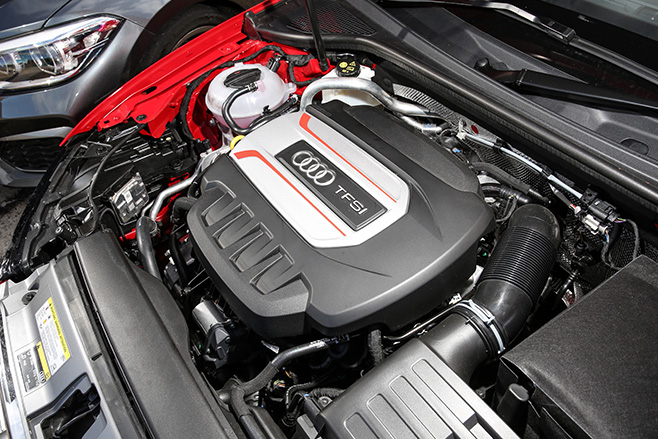You’ve got to admire a manufacturer sticking to its guns. Specifically, if it ain’t broke, don’t fix it.
And that’s precisely the approach both Audi and BMW have taken with their compact five-door scorchers, the S3 Sportback and MY17 M140i respectively. When they’re selling well and giving the customers precisely the experience they’re after, why monkey with the formula? Why indeed.
Of course, keeping one step ahead of the competition is what car-making is all about, so nothing stays the same forever. In the case of this pair of rip-snorting little Euros, that equates to some very carefully chosen tweaks and fiddles here and there, but nothing that was going to fundamentally alter a successful end result.

There are some new graphics and a new set of lights at either end, new alloys (still 18-inch on the S3) and inside, you’ll find a leather-wrapped tiller and Audi’s rather brilliant virtual cockpit dashboard display. As a result of all this, the price has, like the kilowatt count, snuck up slightly (by $1800) to $62,900.
BMW, meanwhile, has made bigger changes (a new generation of engines, for instance) but has been very careful to ensure that the end result is utterly recognisable. So, for 2017, the M140i that replaces the M135i gets the latest, B58, version of the turbocharged inline six, still measuring 3.0 litres while feeling and sounding familiar. There’s new tech on board mainly on the boost side of things, and power is now up to 250kW with torque a full 500Nm (see breakout below).

I don’t know about you, but neither of these hot-shots gives me the visual tingles. The Sportback falls short (well short) of being dumpy, but neither is it particularly slinky. Now, I know hatchbacks, particularly five-door ones, aim to be practical before sexy, but still… The BMW, meanwhile, is even more unfathomable. There’s still a bit of the ‘clown’s shoe’ going on with that Baz Manilow nose and the upswept sill-line and it just never says sporty to me.
Inside, things are less polarising although the overall layout of the BMW’s dashboard is starting to look pretty familiar. Audi had the same problem a couple of years ago, but a big refresh fixed that and is reflected in the new S3.

With the driver’s seat where I’d set it, I couldn’t get my knees or feet into the back of the BMW. A shorter driver and shorter rear-seat passengers would be a different story, but the Audi will always be bigger in the back. I also found the front door opening pretty short in the Bimmer as well, meaning I had to climb around the B-pillar.
Interestingly, both these cars are manuals. In the case of the BMW, that amounts to a special order and probably the same for the Audi.

The point being that by ticking the manual box, you’re giving up a heap of urban convenience and unlike the old days, opting for the third pedal won’t save you a single penny this time around. Not only that, but you’ll also be adding a few tenths to your time across the first 400m of hotmix.

The fact remains, too, that both these cars could do with a well-tailored form of launch control, because they both have their limitations in different ways. The BMW is the simpler of the two to launch hard, partly because it has an old-fashioned park-brake to lean on, but mainly because you’ve got a choice of either spinning the bags or bogging it down.
Maybe there’s that perfect point at which it scuttles off down the strip with just enough wheelspin, but in reality, it builds boost so fast that no matter what you do, it’s going to lay chalkies in first and possibly second.

Speaking of which, for an engine that allegedly has its peak power at 5500rpm, this thing sure wants to hit 7000rpm pretty eagerly. It’s not a rushy top-end, but it’s there and it’s strong just the same.
Really quick shifts can beat the synchro into second, although judging by the state of the tyres on this one (testing was done, err, before photography), it’s had a hard life. And even then, you’ll be hauling through the traps in 13.3 at 178.3 kliks. One-hundred will have arrived at 5.1 and 80 to 120 consumes just 2.8 seconds. Based on the previous model, this proves that the auto is quicker.

Call it 14.1 at 165.5 and 6.2 with 80 to 120 taking a full second longer than the M140i. Again, previous experience tells us the DSG will be quicker, but there’s more to it than just the tranny.
For a start, the engine is very obviously boost-indexed. That is, it makes different boost pressures in different gears and over different rev ranges. In first and second, for instance, there was absolutely no point aiming for the 6500rpm redline, because the boost was done and dusted by the 6000 mark.

In fact, that slight lagginess (and I mean slight) to the way the Audi produces its thrust is felt on the road, too. Okay, so the BMW is a torque monster, and in any other comparison, the S3 would feel entirely lag-free, I’m sure.

If the engine in the BMW is quick, so is the steering ratio. It’s very keen to leave dead-centre, but without being flighty. The problem is that once you do knock it off the straight-ahead, the feel becomes a bit artificial and at odds with the otherwise natural feel, and there’s some reluctance to self-centre.
By contrast the Audi is a more flowing thing to pilot. It’s lighter overall and, in fact, every control from the clutch, to the tiller to the gearshift requires less muscle. And despite that lighter steering, it’s actually nicer to use with what feels like a more linear relationship with what you’re putting in and what the car is giving back.

The BMW, meanwhile, was j-u-s-t acceptable in Comfort mode and way too stiff in Sport to be either comfortable or composed. No, it never lost grip but every now and then when you pile in a bit quick, you can just start to feel the beginnings of a little push. I’d be inclined to blame those stuffed tyres mostly.
The Audi, on the other hand, is doing that Quattro-limpet thing regardless of where or how you drive it and despite the urge it gives away to the BMW, there wouldn’t be much in it in a point-to-point race. Chuck the S3 away on a public road and you could fairly consider yourself a prize pelican.

The M140i, meanwhile, seems to be following that current BMW trend of offering lots of inherent talent, but throwing up a computer-generated fence between you and it, mainly in the way it steers. But then, you floor the Bimmer away from a standing start and feel 500Nm pressing you into that lovely red leather and you might just be convinced to change your mind.
Me, I wouldn’t buy either of them… not enough visual attraction. I’d stretch the lease by another ten grand and buy an M240i. And I’d get the eight-speed auto. And, yes, I know that’s not the question you asked.

SPECS


Meet the B58
BMW’s new 3.0-litre inline-6
The new engine-tech contained within BMW’s B58 includes moving the twin-scroll turbocharger closer to the manifold for better response and for shorter cat light-off times. The old air-to-air intercooler of the previous model has been replaced with a water-to-air intercooler and, cleverly in a packaging sense, the ‘cooler lives in the inlet manifold.=

And there’s more to it than that. The whole thing has been designed for strength and durability, suggesting that there’s plenty of headroom in the design. The old engine’s iron cylinder sleeves have been replaced by a process called electric arc wire spraying, also known as plasma coating. This leaves a thin, but tough, coating on the raw aluminium block, mitigating the need for separate sleeves.
The B58 also features a ‘closed deck’ design in which the top of each cylinder is completely supported by the rest of the block, rather than just in a couple of places. Even though that makes the engine more expensive to make and a little heavier, the closed deck gives the block more rigidity and the capacity to handle high boost pressures with distortion.
And probably just as well, since the B58 is said to produce 20 per cent more boost than its forebear and runs a high 11:1 compression ratio.





